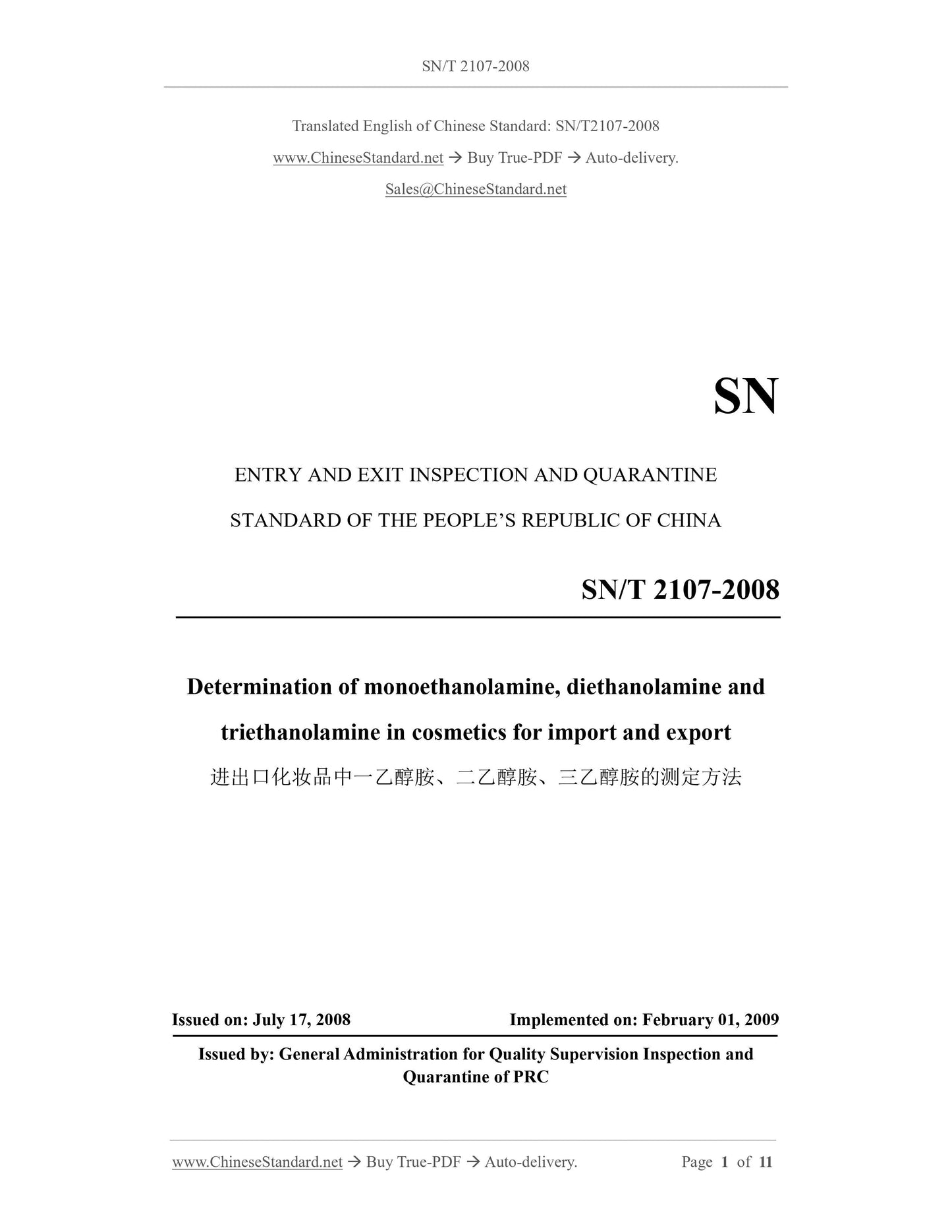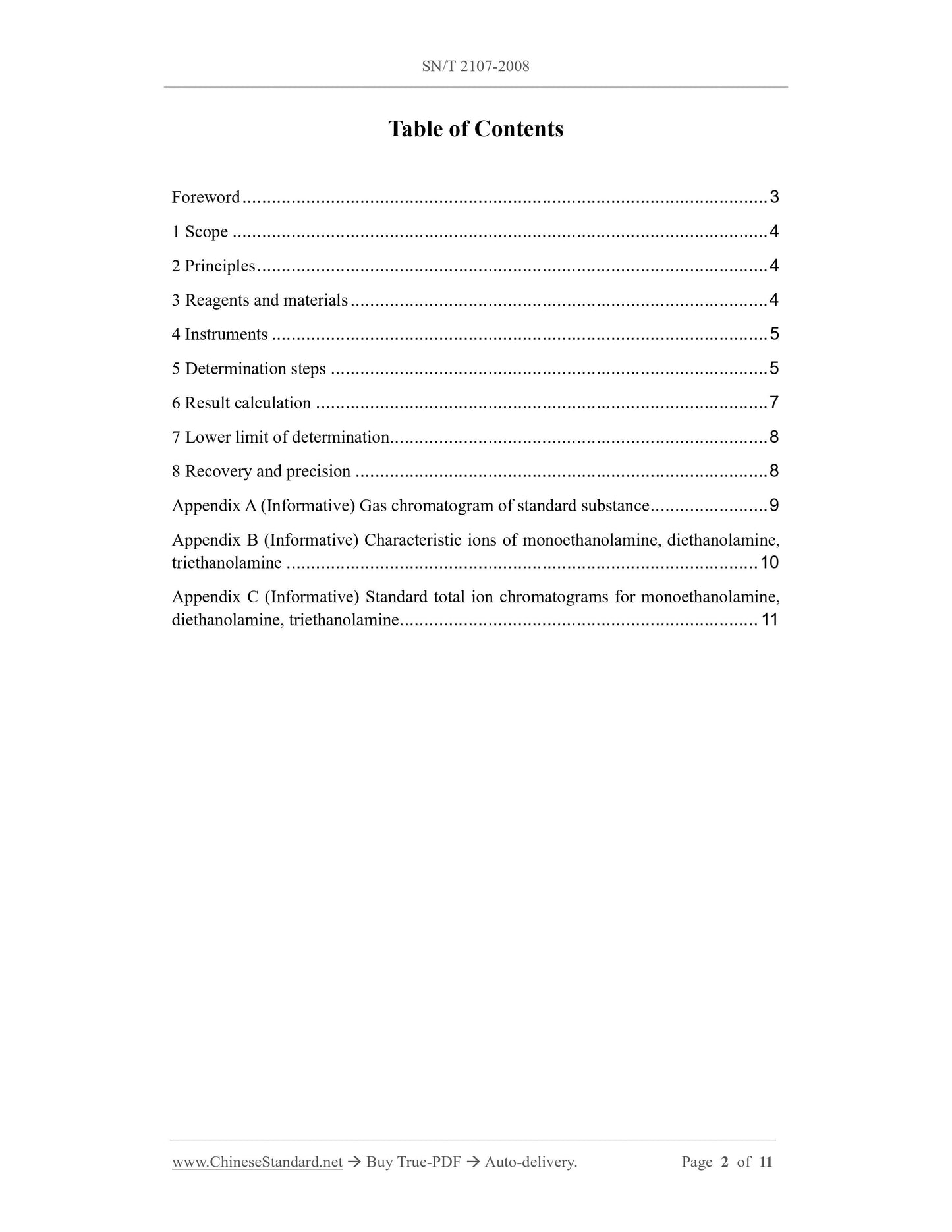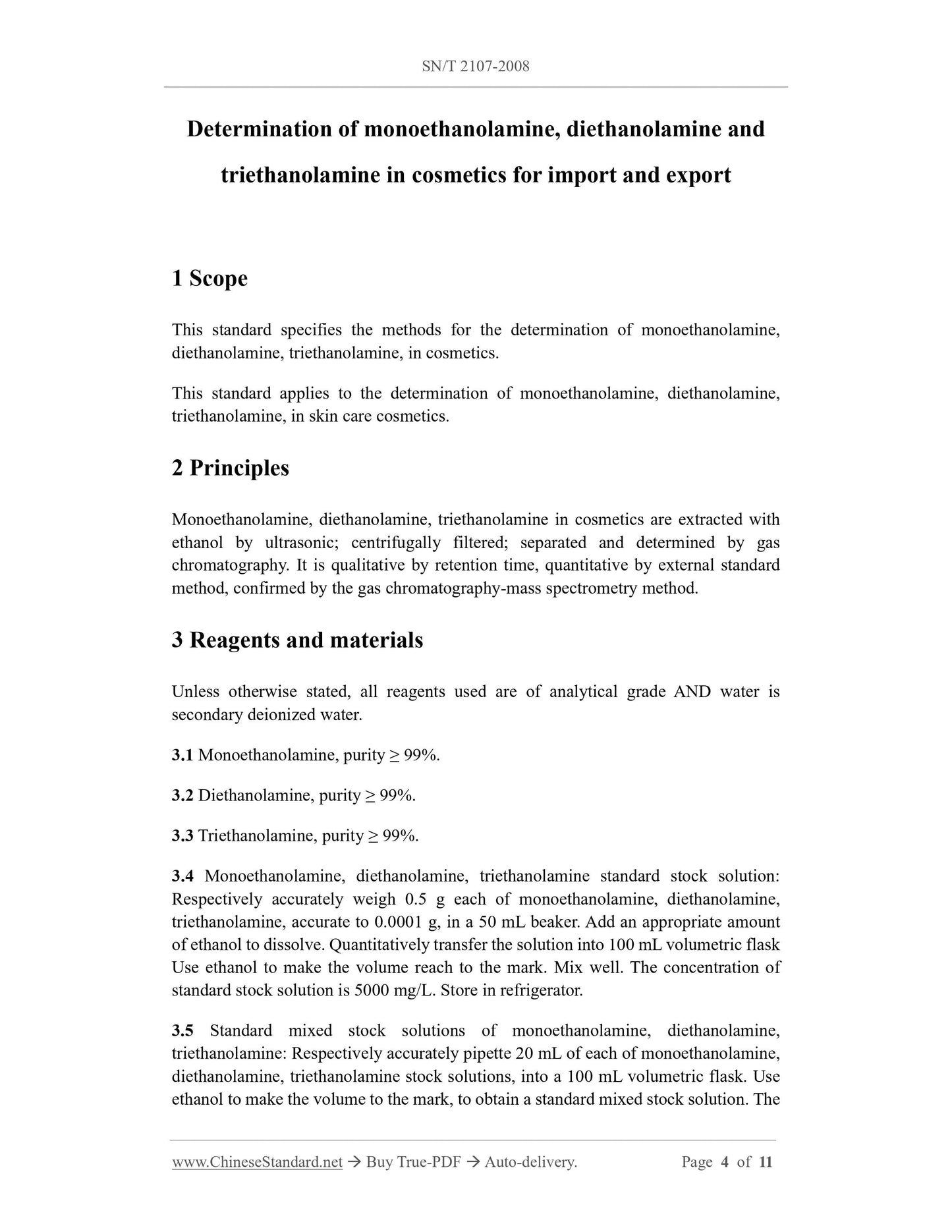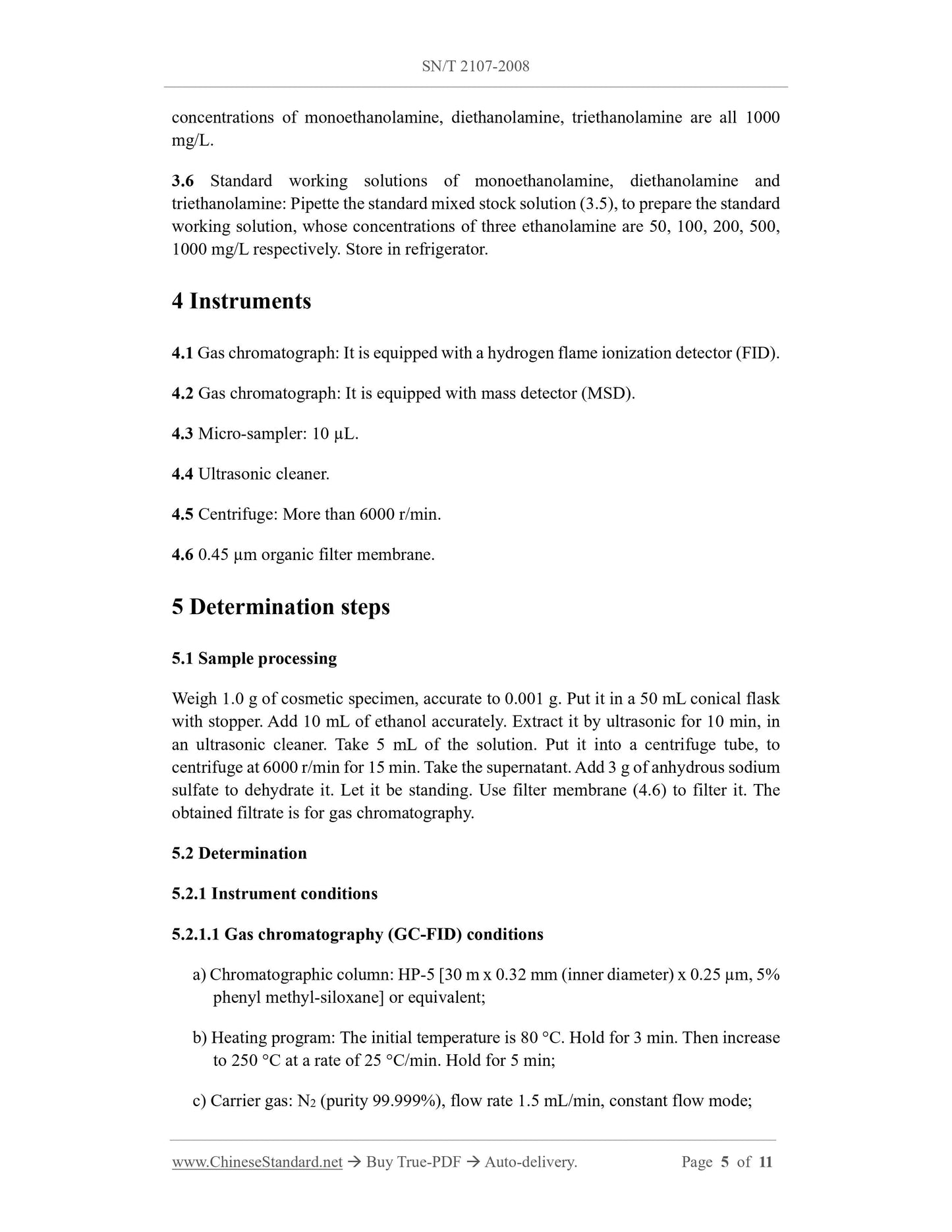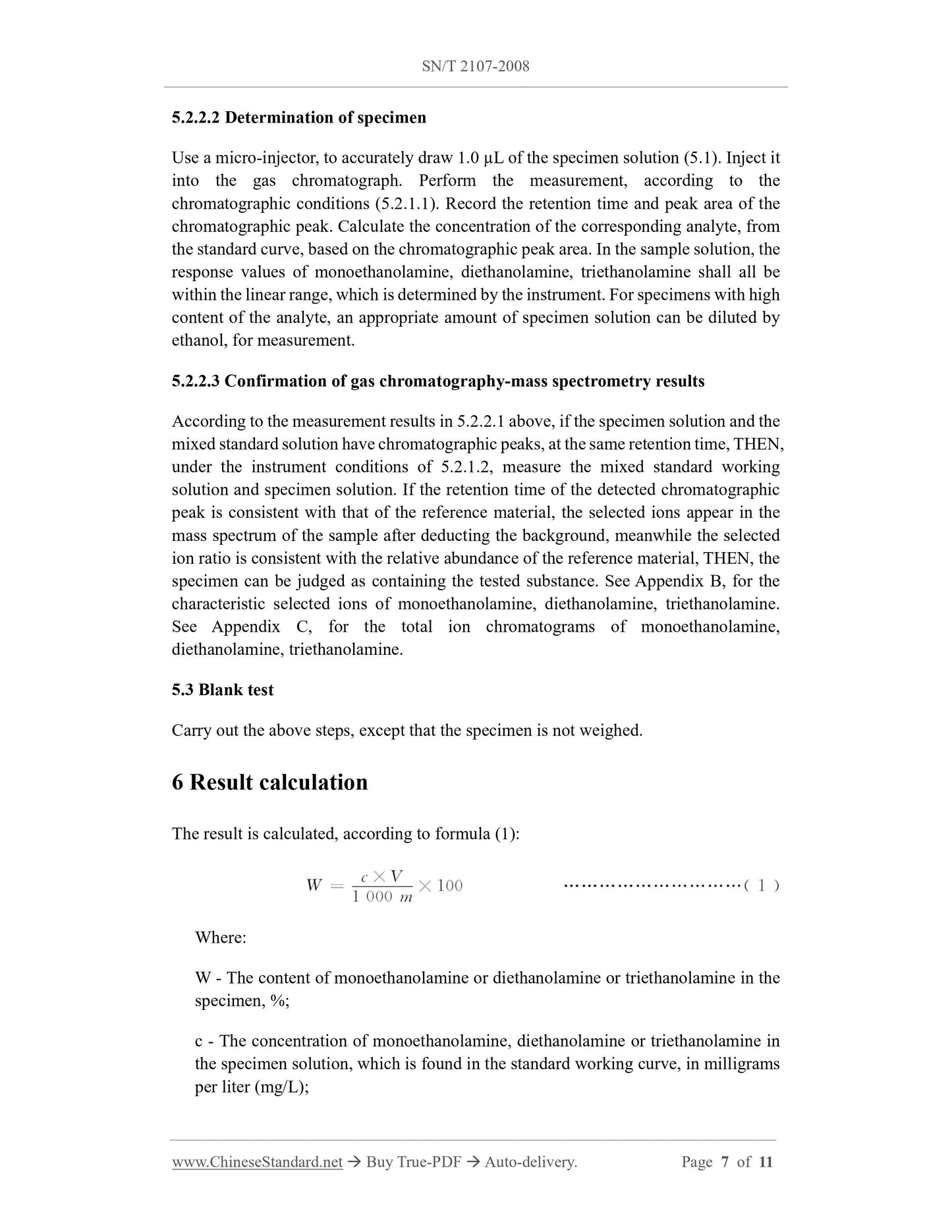PayPal, credit cards. Download editable-PDF and invoice in 1 second!
SN/T 2107-2008 English PDF (SNT2107-2008)
SN/T 2107-2008 English PDF (SNT2107-2008)
Precio habitual
$100.00 USD
Precio habitual
Precio de oferta
$100.00 USD
Precio unitario
/
por
Los gastos de envío se calculan en la pantalla de pago.
No se pudo cargar la disponibilidad de retiro
Delivery: 3 seconds. Download true-PDF + Invoice.
Get QUOTATION in 1-minute: Click SN/T 2107-2008
Historical versions: SN/T 2107-2008
Preview True-PDF (Reload/Scroll if blank)
SN/T 2107-2008: Determination of monoethanolamine, diethanolamine and triethanolamine in cosmetics for import and export
SN/T 2107-2008
SN
ENTRY AND EXIT INSPECTION AND QUARANTINE
STANDARD OF THE PEOPLE’S REPUBLIC OF CHINA
Determination of monoethanolamine, diethanolamine and
triethanolamine in cosmetics for import and export
ISSUED ON: JULY 17, 2008
IMPLEMENTED ON: FEBRUARY 01, 2009
Issued by: General Administration for Quality Supervision Inspection and
Quarantine of PRC
Table of Contents
Foreword ... 3
1 Scope ... 4
2 Principles ... 4
3 Reagents and materials ... 4
4 Instruments ... 5
5 Determination steps ... 5
6 Result calculation ... 7
7 Lower limit of determination... 8
8 Recovery and precision ... 8
Appendix A (Informative) Gas chromatogram of standard substance ... 9
Appendix B (Informative) Characteristic ions of monoethanolamine, diethanolamine,
triethanolamine ... 10
Appendix C (Informative) Standard total ion chromatograms for monoethanolamine,
diethanolamine, triethanolamine ... 11
Determination of monoethanolamine, diethanolamine and
triethanolamine in cosmetics for import and export
1 Scope
This standard specifies the methods for the determination of monoethanolamine,
diethanolamine, triethanolamine, in cosmetics.
This standard applies to the determination of monoethanolamine, diethanolamine,
triethanolamine, in skin care cosmetics.
2 Principles
Monoethanolamine, diethanolamine, triethanolamine in cosmetics are extracted with
ethanol by ultrasonic; centrifugally filtered; separated and determined by gas
chromatography. It is qualitative by retention time, quantitative by external standard
method, confirmed by the gas chromatography-mass spectrometry method.
3 Reagents and materials
Unless otherwise stated, all reagents used are of analytical grade AND water is
secondary deionized water.
3.1 Monoethanolamine, purity ≥ 99%.
3.2 Diethanolamine, purity ≥ 99%.
3.3 Triethanolamine, purity ≥ 99%.
3.4 Monoethanolamine, diethanolamine, triethanolamine standard stock solution:
Respectively accurately weigh 0.5 g each of monoethanolamine, diethanolamine,
triethanolamine, accurate to 0.0001 g, in a 50 mL beaker. Add an appropriate amount
of ethanol to dissolve. Quantitatively transfer the solution into 100 mL volumetric flask
Use ethanol to make the volume reach to the mark. Mix well. The concentration of
standard stock solution is 5000 mg/L. Store in refrigerator.
3.5 Standard mixed stock solutions of monoethanolamine, diethanolamine,
triethanolamine: Respectively accurately pipette 20 mL of each of monoethanolamine,
diethanolamine, triethanolamine stock solutions, into a 100 mL volumetric flask. Use
ethanol to make the volume to the mark, to obtain a standard mixed stock solution. The
concentrations of monoethanolamine, diethanolamine, triethanolamine are all 1000
mg/L.
3.6 Standard working solutions of monoethanolamine, diethanolamine and
triethanolamine: Pipette the standard mixed stock solution (3.5), to prepare the standard
working solution, whose concentrations of three ethanolamine are 50, 100, 200, 500,
1000 mg/L respectively. Store in refrigerator.
4 Instruments
4.1 Gas chromatograph: It is equipped with a hydrogen flame ionization detector (FID).
4.2 Gas chromatograph: It is equipped with mass detector (MSD).
4.3 Micro-sampler: 10 µL.
4.4 Ultrasonic cleaner.
4.5 Centrifuge: More than 6000 r/min.
4.6 0.45 µm organic filter membrane.
5 Determination steps
5.1 Sample processing
Weigh 1.0 g of cosmetic specimen, accurate to 0.001 g. Put it in a 50 mL conical flask
with stopper. Add 10 mL of ethanol accurately. Extract it by ultrasonic for 10 min, in
an ultrasonic cleaner. Take 5 mL of the solution. Put it into a centrifuge tube, to
centrifuge at 6000 r/min for 15 min. Take the supernatant. Add 3 g of anhydrous sodium
sulfate to dehydrate it. Let it be standing. Use filter membrane (4.6) to filter it. The
obtained filtrate is for gas chromatography.
5.2 Determination
5.2.1 Instrument conditions
5.2.1.1 Gas chromatography (GC-FID) conditions
a) Chromatographic column: HP-5 [30 m x 0.32 mm (inner diameter) x 0.25 µm, 5%
phenyl methyl-siloxane] or equivalent;
b) Heating program: The initial temperature is 80 °C. Hold for 3 min. Then increase
to 250 °C at a rate of 25 °C/min. Hold for 5 min;
c) Carrier gas: N2 (purity 99.999%), flow rate 1.5 mL/min, constant flow mode;
5.2.2.2 Determination of specimen
Use a micro-injector, to accurately draw 1.0 µL of the specimen solution (5.1). Inject it
into the gas chromatograph. Perform the measurement, according to the
chromatographic conditions (5.2.1.1). Record the retention time and peak area of the
chromatographic peak. Calculate the concentration of the corresponding analyte, from
the standard curve, based on the chromatographic peak area. In the sample solution, the
response values of monoethanolamine, diethanolamine, triethanolamine shall all be
within the linear range, which is determined by the instrument. For specimens with high
content of the analyte, an appropriate amount of specimen solution can be diluted by
ethanol, for measurement.
5.2.2.3 Confirmation of gas chromatography-mass spectrometry results
According to the measurement results in 5.2.2.1 above, if the specimen solution and the
mixed standard solution have chromatographic peaks, at the same retention time, THEN,
under the instrument conditions of 5.2.1.2, measure the mixed standard working
solution and specimen solution. If the retention time of the detected chromatographic
peak is consistent with that of the reference material, the selected ions appear in the
mass spectrum of the sample after deducting the background, meanwhile the selected
ion ratio is consistent with the relative abundance of the reference material, THEN, the
specimen can be judged as containing the tested substance. See Appendix B, for the
characteristic selected ions of monoethanolamine, diethanolamine, triethanolamine.
See Appendix C, for the total ion chromatograms of monoethanolamine,
diethanolamine, triethanolamine.
5.3 Blank test
Carry out the above steps, except that the specimen is not weighed.
6 Result calculation
The result is calculated, according to formula (1):
Where:
W - The content of monoethanolamine or diethanolamine or triethanolamine in the
specimen, %;
c - The concentration of monoethanolamine, diethanolamine or triethanolamine in
the specimen solution, which is found in the standard working curve, in milligrams
per liter (mg/L);
Get QUOTATION in 1-minute: Click SN/T 2107-2008
Historical versions: SN/T 2107-2008
Preview True-PDF (Reload/Scroll if blank)
SN/T 2107-2008: Determination of monoethanolamine, diethanolamine and triethanolamine in cosmetics for import and export
SN/T 2107-2008
SN
ENTRY AND EXIT INSPECTION AND QUARANTINE
STANDARD OF THE PEOPLE’S REPUBLIC OF CHINA
Determination of monoethanolamine, diethanolamine and
triethanolamine in cosmetics for import and export
ISSUED ON: JULY 17, 2008
IMPLEMENTED ON: FEBRUARY 01, 2009
Issued by: General Administration for Quality Supervision Inspection and
Quarantine of PRC
Table of Contents
Foreword ... 3
1 Scope ... 4
2 Principles ... 4
3 Reagents and materials ... 4
4 Instruments ... 5
5 Determination steps ... 5
6 Result calculation ... 7
7 Lower limit of determination... 8
8 Recovery and precision ... 8
Appendix A (Informative) Gas chromatogram of standard substance ... 9
Appendix B (Informative) Characteristic ions of monoethanolamine, diethanolamine,
triethanolamine ... 10
Appendix C (Informative) Standard total ion chromatograms for monoethanolamine,
diethanolamine, triethanolamine ... 11
Determination of monoethanolamine, diethanolamine and
triethanolamine in cosmetics for import and export
1 Scope
This standard specifies the methods for the determination of monoethanolamine,
diethanolamine, triethanolamine, in cosmetics.
This standard applies to the determination of monoethanolamine, diethanolamine,
triethanolamine, in skin care cosmetics.
2 Principles
Monoethanolamine, diethanolamine, triethanolamine in cosmetics are extracted with
ethanol by ultrasonic; centrifugally filtered; separated and determined by gas
chromatography. It is qualitative by retention time, quantitative by external standard
method, confirmed by the gas chromatography-mass spectrometry method.
3 Reagents and materials
Unless otherwise stated, all reagents used are of analytical grade AND water is
secondary deionized water.
3.1 Monoethanolamine, purity ≥ 99%.
3.2 Diethanolamine, purity ≥ 99%.
3.3 Triethanolamine, purity ≥ 99%.
3.4 Monoethanolamine, diethanolamine, triethanolamine standard stock solution:
Respectively accurately weigh 0.5 g each of monoethanolamine, diethanolamine,
triethanolamine, accurate to 0.0001 g, in a 50 mL beaker. Add an appropriate amount
of ethanol to dissolve. Quantitatively transfer the solution into 100 mL volumetric flask
Use ethanol to make the volume reach to the mark. Mix well. The concentration of
standard stock solution is 5000 mg/L. Store in refrigerator.
3.5 Standard mixed stock solutions of monoethanolamine, diethanolamine,
triethanolamine: Respectively accurately pipette 20 mL of each of monoethanolamine,
diethanolamine, triethanolamine stock solutions, into a 100 mL volumetric flask. Use
ethanol to make the volume to the mark, to obtain a standard mixed stock solution. The
concentrations of monoethanolamine, diethanolamine, triethanolamine are all 1000
mg/L.
3.6 Standard working solutions of monoethanolamine, diethanolamine and
triethanolamine: Pipette the standard mixed stock solution (3.5), to prepare the standard
working solution, whose concentrations of three ethanolamine are 50, 100, 200, 500,
1000 mg/L respectively. Store in refrigerator.
4 Instruments
4.1 Gas chromatograph: It is equipped with a hydrogen flame ionization detector (FID).
4.2 Gas chromatograph: It is equipped with mass detector (MSD).
4.3 Micro-sampler: 10 µL.
4.4 Ultrasonic cleaner.
4.5 Centrifuge: More than 6000 r/min.
4.6 0.45 µm organic filter membrane.
5 Determination steps
5.1 Sample processing
Weigh 1.0 g of cosmetic specimen, accurate to 0.001 g. Put it in a 50 mL conical flask
with stopper. Add 10 mL of ethanol accurately. Extract it by ultrasonic for 10 min, in
an ultrasonic cleaner. Take 5 mL of the solution. Put it into a centrifuge tube, to
centrifuge at 6000 r/min for 15 min. Take the supernatant. Add 3 g of anhydrous sodium
sulfate to dehydrate it. Let it be standing. Use filter membrane (4.6) to filter it. The
obtained filtrate is for gas chromatography.
5.2 Determination
5.2.1 Instrument conditions
5.2.1.1 Gas chromatography (GC-FID) conditions
a) Chromatographic column: HP-5 [30 m x 0.32 mm (inner diameter) x 0.25 µm, 5%
phenyl methyl-siloxane] or equivalent;
b) Heating program: The initial temperature is 80 °C. Hold for 3 min. Then increase
to 250 °C at a rate of 25 °C/min. Hold for 5 min;
c) Carrier gas: N2 (purity 99.999%), flow rate 1.5 mL/min, constant flow mode;
5.2.2.2 Determination of specimen
Use a micro-injector, to accurately draw 1.0 µL of the specimen solution (5.1). Inject it
into the gas chromatograph. Perform the measurement, according to the
chromatographic conditions (5.2.1.1). Record the retention time and peak area of the
chromatographic peak. Calculate the concentration of the corresponding analyte, from
the standard curve, based on the chromatographic peak area. In the sample solution, the
response values of monoethanolamine, diethanolamine, triethanolamine shall all be
within the linear range, which is determined by the instrument. For specimens with high
content of the analyte, an appropriate amount of specimen solution can be diluted by
ethanol, for measurement.
5.2.2.3 Confirmation of gas chromatography-mass spectrometry results
According to the measurement results in 5.2.2.1 above, if the specimen solution and the
mixed standard solution have chromatographic peaks, at the same retention time, THEN,
under the instrument conditions of 5.2.1.2, measure the mixed standard working
solution and specimen solution. If the retention time of the detected chromatographic
peak is consistent with that of the reference material, the selected ions appear in the
mass spectrum of the sample after deducting the background, meanwhile the selected
ion ratio is consistent with the relative abundance of the reference material, THEN, the
specimen can be judged as containing the tested substance. See Appendix B, for the
characteristic selected ions of monoethanolamine, diethanolamine, triethanolamine.
See Appendix C, for the total ion chromatograms of monoethanolamine,
diethanolamine, triethanolamine.
5.3 Blank test
Carry out the above steps, except that the specimen is not weighed.
6 Result calculation
The result is calculated, according to formula (1):
Where:
W - The content of monoethanolamine or diethanolamine or triethanolamine in the
specimen, %;
c - The concentration of monoethanolamine, diethanolamine or triethanolamine in
the specimen solution, which is found in the standard working curve, in milligrams
per liter (mg/L);
Share
